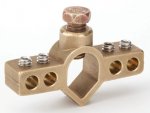kwired
Electron manager
- Location
- NE Nebraska
- Occupation
- EC
Checked my own house this past weekend and sure enough, the copper lines were not bonded, couldn't believe it. My house is not very old either; suprized this wasen't cought (I'm not the original owner). Before bonding, I checked for mV AC at my electric water tank copper lines. I checked it to a receptacle in the area ground. There was about 220mV on it. I turned off the water heater and that levle went down some. Proceeded to bond across the hot and cold at the water tank and across the in/out of my water softener. My GEC was #4 based on the diameter with a dial indicator so i took the bond from my water line by my panel to the GEC with a split bolt. Worked out quite well. I then checked continuity at my water heater to the same receptace and got good continuity. I then checked mV again and it was about 8mV AC. I guee my only concern now is why was there mV on my water line and now that I grounded it, will I get problem with pinhole leaks in my copper lines because the voltage is flowing per say, not just present as before?
Could have (likely was) just capacitive coupling creating this voltage. You will have more problems with degrading of the line from DC current and electrolysis than you will have from AC current.



